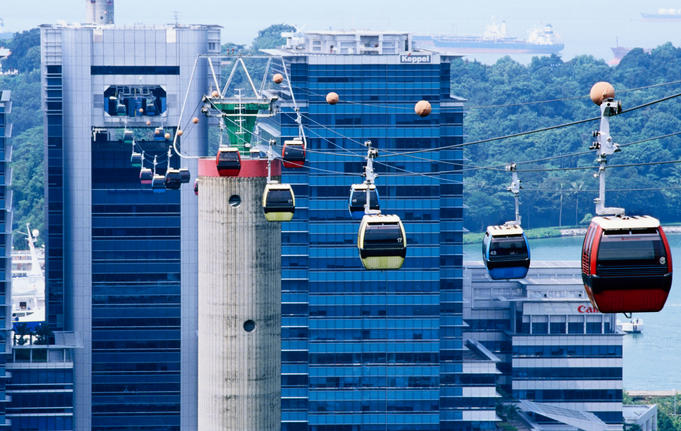
In a time when every public entity
is trying to spend less and still provide adequate transportation options to
its constituents, I found myself looking to the sky. Intra-urban planes would be a bit overkill,
and mimicking Sao Paulo’s 420 helipads (in the city!) is just too
inequitable. What I’m looking at is the
gondola or aerial tram or Cable Propelled
Transit (CPT). It is fast becoming
one of the most popular, least-used forms of urban mass transit in the world. There
are only four cities in the world, according to The Gondola Project (arguably the global
leader in CPT proselytization), that have truly integrated their CPT into their
whole transit system: Caracas, Venezuela; Constantine, Algeria; Rio de Janeiro,
Brazil; and Medellin, Colombia. Otherwise,
most cities have short, single, experimental or tourist-based lines like
Portland’s aerial tram or the Rostok/ Munich lift that was disassembled in Rostok to follow a garden exhibition traveling to Munich. However, more and more of these experiments
are planting themselves all over the map, like the London Thames Cable Car; the
urban gondola in Ordu, Turkey; or the Teléferico de Gaia in
Portugal. Why is this form of transit
becoming popular?
 |
| Caracas, Venezuela -- Metrocable |
 |
| London Thames Car |
An article
in the Journal for Transportation Engineering assessed CPT (which they call
Aerial Ropeway Transit or APT) technology and its pros and cons as urban
transit. A few of the pros are 1) it is energy efficient due to its
utilization of gravity and counterbalancing, 2) it is relatively inexpensive
(on par with BRT costs), and 3) is much more flexible when it comes to
mountainous or water-laden terrain. It is true that the vast majority of
CPT systems are used to get people up to a high place, down to a low place,
or over a watery place, but, again quoting from The Gondola Project, “city traffic may be the ultimate urban topographical challenge.”
Establishing a solid, urban example of a CPT that did not take
advantage of difficult topography would grab the attention of cities looking
for a cheap, viable method of transit, but can currently only see CPT ferrying
people up to the diamond black ski runs.
 |
| Rio de Janeiro |
The cons listed in the
aforementioned article are noteworthy. They include issues like
difficulty integrating with existing transit systems; almost no examples of
lines branching off or turning; and passenger loads that can’t compete with
light rail or even BRT. There is also the overwhelming idea that CPT, in
my opinion, comes off as more of an amusement park ride than a viable way to
get to a destination. A negative public perception, valid or not,
certainly makes an impression on the planner’s success in introducing a mode of
transportation. One of the worries that frequently pops up when a
community considers CPT, according to the Gondola Project’s FAQ, is if it will
perform well in icy and windy conditions. This is ironic considering its
most commonly known use is by ski resorts. I’m certain, as more
established cities (see: industrialized, wealthy, powerful, North
Hemispherical) have gondola success stories, this perception will change.
 |
| Conceptual Cable Car Considered for Chicago |
The restriction for transporting people in anything but a straight line is not as rare as the article made it out to be. In fact, though not as frequently built as straight lines, slight curves and even ninety degree turns have been achieved in CPT. I think the capacity issue would be overcome if it was proven to be more reliable than light rail or BRT. In addition, technology could improve the capacity as the demand rises. I think the biggest hurdle CPT has to clear is the public perception that it's some flimsy joy-ride for tourists. Is CPT something cities should seriously consider as a part of their transportation system? Or is this a gimmick that could work only in niche areas? Have you ever utilized CPT aside from Portland's aerial tram?
This post was reviewed by Sravya Garladenne.
 |
| Singapore Cable Car |

Very interesting article. With the right kind of technology and support, CPTs could be implemented in urban areas as a means to shuffle people around. As pointed out in the article, "city traffic may be the ultimate urban topographical challenge". Therefore I think it becomes even more critical not to rule out alternative modes of transit that could be useful. As opposed to picking the "best" or most effective mode, why not have diversity in transportation? BRTs linking up to CPTs. I can see the argument that CPTs have an image associated with amusement parks, yet it is this very reason that might intrigue a person to even consider using CPT as opposed to driving a car. The very idea that it could actually be fun could persuade commuters into taking public transit more often. If done right, CPTs could not only effective but a reminder to commuters that there are options when it comes to mass transit, and ones with such a view! Thanks for the post.
ReplyDelete